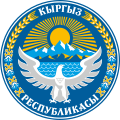Related Research Articles

Pumped-storage hydroelectricity (PSH), or pumped hydroelectric energy storage (PHES), is a type of hydroelectric energy storage used by electric power systems for load balancing. The method stores energy in the form of gravitational potential energy of water, pumped from a lower elevation reservoir to a higher elevation. Low-cost surplus off-peak electric power is typically used to run the pumps. During periods of high electrical demand, the stored water is released through turbines to produce electric power. Although the losses of the pumping process make the plant a net consumer of energy overall, the system increases revenue by selling more electricity during periods of peak demand, when electricity prices are highest. If the upper lake collects significant rainfall or is fed by a river then the plant may be a net energy producer in the manner of a traditional hydroelectric plant.

Hydroelectricity, or hydroelectric power, is electricity generated from hydropower. Hydropower supplies one sixth of the world's electricity, almost 4500 TWh in 2020, which is more than all other renewable sources combined and also more than nuclear power. Hydropower can provide large amounts of low-carbon electricity on demand, making it a key element for creating secure and clean electricity supply systems. A hydroelectric power station that has a dam and reservoir is a flexible source, since the amount of electricity produced can be increased or decreased in seconds or minutes in response to varying electricity demand. Once a hydroelectric complex is constructed, it produces no direct waste, and almost always emits considerably less greenhouse gas than fossil fuel-powered energy plants. However, when constructed in lowland rainforest areas, where part of the forest is inundated, substantial amounts of greenhouse gases may be emitted.

Toktogul Dam is a hydroelectric and irrigation dam on the Naryn River in the Jalal-Abad Province of Kyrgyzstan. It is concrete gravity dam with height of 215 metres (705 ft) and length of 292.5 metres (960 ft). It is a part of the Naryn-Syr Darya cascade. It is named after Toktogul Satilganov.

China is the world's leader in electricity production from renewable energy sources, with over triple the generation of the second-ranking country, the United States. China's renewable energy sector is growing faster than its fossil fuels and nuclear power capacity, and is expected to contribute 43 per cent of global renewable capacity growth. China's total renewable energy capacity exceeded 1,000 GW in 2021, accounting for 43.5 per cent of the country's total power generation capacity, 10.2 percentage points higher than in 2015. The country aims to have 80 per cent of its total energy mix come from non-fossil fuel sources by 2060, and achieve a combined 1,200 GW of solar and wind capacity by 2030. In 2023, it was reported that China was on track to reach 1,371 gigawatts of wind and solar by 2025, five years ahead of target due to new renewables installations smashing records.

Energy in Armenia is mostly from natural gas. Armenia has no proven reserves of oil or natural gas and currently imports most of its gas from Russia. The Iran-Armenia Natural Gas Pipeline has the capacity to equal imports from Russia.

China's electric power industry is the world's largest electricity producer, passing the United States in 2011 after rapid growth since the early 1990s. In 2021, China produced 8.5 petawatt-hour (Pwh) of electricity, approximately 30% of the world's electricity. In 2019, China had produced 7.3 petawatt-hour (PWh) of electricity, more than the next three countries combined.

The Kambar-Ata-2 Hydro Power Plant is a hydroelectric power station on the river Naryn near Kara-Jygach, Toktogul District, Kyrgyzstan. When completed, it will have 3 individual Francis turbine-generators with a nominal output of around 120 MW each which will deliver up to 360 MW of power. The first generator was operational on November 27, 2010. The power plant's dam is 60 m (197 ft) tall and it creates a 70,000,000 m3 (56,750 acre⋅ft) reservoir of which 8,000,000 m3 (6,486 acre⋅ft) is active for power generation.
The Kazarman hydropower cascade is a future hydropower project near Kazarman in Jalal-Abad Region, Kyrgyzstan. When completed, it will consist of 4 hydropower plants on the river Naryn: Ala-Buga, Kara-Bulung-1, Kara-Bulung-2 and Toguz-Toro, with a total installed capacity of 1160 MW.

The Shamaldy-Say Hydro Power Plant is an active hydro power plant on the river Naryn between Tash-Kömür and Shamaldy-Say, in Kyrgyzstan. Completed between 1992 and 1996, it is one of the three hydro power plants on the river Naryn near Tash-Kömür, 14 km downstream from the Tash-Kömür Hydroelectric Power Station. It has 3 individual turbines with a nominal output of around 80 MW and a total nominal capacity of 180 MW. The power plant's dam is 37 m (121 ft) tall and it creates a 41,000,000 m3 (33,239 acre⋅ft) reservoir of which 5,500,000 m3 (4,459 acre⋅ft) is active for power generation.
The Tash-Kömür Hydro Power Plant is a hydroelectric power plant on the river Naryn in Tash-Kömür, Kyrgyzstan. Completed between 1985 and 1987, it is one of the three hydro power plants on the river Naryn near Tash-Kömür, 14 km upstream from the Shamaldy-Say Hydroelectric Power Station. It has 3 individual turbines with a nominal output of around 150 MW and a total nominal capacity of 450 MW. The power plant's dam is 75 m (246 ft) tall and it creates a 140,000,000 m3 (113,500 acre⋅ft) reservoir of which 10,000,000 m3 (8,107 acre⋅ft) is active for power generation.
The Üch-Korgon Hydro Power Plant is an active hydro power plant on the river Naryn in Shamaldy-Say, Kyrgyzstan, upstream from Uchqoʻrgʻon in Uzbekistan. Completed in 1962, it is the oldest of the three hydro power plants on the river Naryn near Tash-Kömür, 25 km downstream from the Shamaldy-Say Hydroelectric Power Station. It has 4 individual turbines with a nominal output of around 45 MW and a total nominal capacity of 180 MW. The power plant's dam is 34 m (112 ft) tall and it creates a 53,000,000 m3 (42,968 acre⋅ft) reservoir of which20,000,000 m3 (16,214 acre⋅ft) is active for power generation.
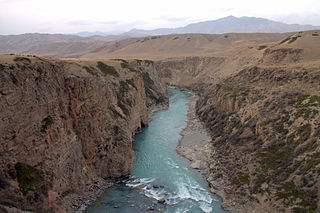
The Upper Naryn hydropower cascade is a hydropower project in Naryn Region, Kyrgyzstan. When completed, it will consist of 4 hydropower plants on the river Naryn: Ak-Bulung, Naryn-1, Naryn-2 and Naryn-3, with a total installed capacity of 238 MW.
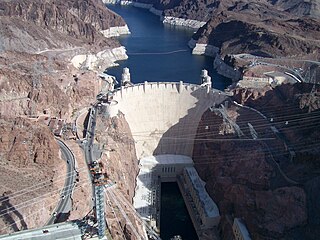
Hydroelectricity is, as of 2019, the second-largest renewable source of energy in both generation and nominal capacity in the United States. In 2021, hydroelectric power produced 31.5% of the total renewable electricity, and 6.3% of the total U.S. electricity.

Renewable energy in Russia mainly consists of hydroelectric energy. In 2010, the country was the sixth largest producer of renewable energy in the world, although it was 56th when hydroelectric energy was not taken into account. Some 179 TWh of Russia's energy production came from renewable energy sources, out of a total economically feasible potential of 1823 TWh. 16% of Russia's electricity was generated from hydropower, and less than 1% was generated from all other renewable energy sources combined. Roughly 68% of Russia's electricity was generated from thermal power and 16% from nuclear power.
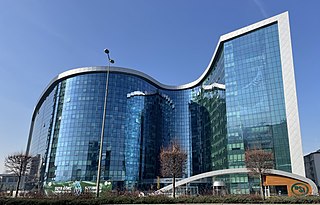
Hydroelectricity is a major source of electricity in Turkey, due to its mountainous landscape and many rivers. The country's main river basins are the Euphrates and Tigris. Over 700 hydropower plants have been built, and they make up about 30% of the country's electricity generating capacity. Annual generation varies greatly, and in rainy years lots of hydroelectric power can be generated. Government policies have generally supported building dams, but some are controversial in neighbouring countries, and some raise concerns about damage to the environment and wildlife.
Thailand has set targets and policies for the development of its energy sector for 2035, with priority being given to indigenous renewable energy resources, including hydropower.

Hydroelectricity is currently China's largest renewable energy source and the second overall after coal. According to the International Hydropower Association, China is the worlds largest producer of hydroelectricity as of 2021. China's installed hydroelectric capacity in 2021 was 390.9 GW, including 36.4 GW of pumped storage hydroelectricity capacity, up from 233 GW in 2011. That year, hydropower generated 1,300 TWh of power, an increase of 68 TWh over 2018 when hydropower generated 1,232 TWh of power, accounting for roughly 18% of China's total electricity generation.
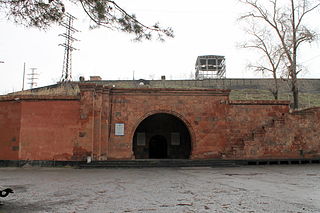
Sevan–Hrazdan Cascade is a complex of hydroelectric power plants on the Hrazdan River and its tributaries between the Lake Sevan and Yerevan in Armenia. They use irrigation water flow from the Lake Sevan and streams waters of Hrazdan River. The cascade is owned by the International Energy Corporation (IEC), a subsidiary of Tashir Group owned by Samvel Karapetyan.
Vietnam utilizes four main sources of renewable energy: hydroelectricity, wind power, solar power and biomass. By the end of 2018, hydropower was the largest source of renewable energy, contributing about 40% to the total national electricity capacity. In 2020, wind and solar had a combined share of 10% of the country's electrical generation, already meeting the government's 2030 goal, suggesting future displacement of growth of coal capacity. By the end of 2020, the total installed capacity of solar and wind power had reached over 17 GW. Over 25% of total power capacity is from variable renewable energy sources. The commercial biomass electricity generation is currently slow and limited to valorizing bagasse only, but the stream of forest products, agricultural and municipal waste is increasing. The government is studying a renewable portfolio standard that could promote this energy source.

In Ukraine, the share of renewables within the total energy mix is less than 5%. In 2020 10% of electricity was generated from renewables; made up of 5% hydro, 4% wind, and 1% solar. Biomass provides renewable heat.
References
- 1 2 "Eurasia, Data browser". International Energy Agency (IEA). Retrieved 19 January 2022.
- ↑ "CMD projects in the Kyrgyz Republic. Hydropower" (PDF). 2011.
- ↑ "List of the main hydropower facilities of the Kyrgyz Republic" (PDF). CAWater-Info (in Russian). Retrieved 19 January 2022.
- ↑ National Energy Holding (2020). "Promising investment projects in the energy sector" (PDF) (in Russian).
- ↑ "The Action Plan for the implementation of the National Development Program until 2026 was approved" (in Russian). Cabinet of Ministers of the Kyrgyz Republic. 13 January 2022.
